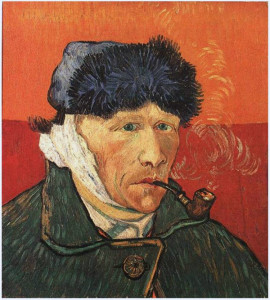By Lida Prypchan
 After a bit of persuasion, French neo-impressionist painter, Paul Gauguin, joined Vincent van Gogh at the Yellow House in Arles in October of 1888. Vincent had high hopes for a future partnership for the pair. Ultimately, Vincent wanted Paul to join him in setting up an artist’s colony and school, and in preparation for Gauguin’s coming, Vincent began to paint one of his most recognizable subjects – sunflowers.
After a bit of persuasion, French neo-impressionist painter, Paul Gauguin, joined Vincent van Gogh at the Yellow House in Arles in October of 1888. Vincent had high hopes for a future partnership for the pair. Ultimately, Vincent wanted Paul to join him in setting up an artist’s colony and school, and in preparation for Gauguin’s coming, Vincent began to paint one of his most recognizable subjects – sunflowers.
Van Gogh and Gaugin worked side-by-side in Vincent’s ground floor artist’s studio in the Yellow House. Vincent decorated Gauguin’s second-floor room with portraits of sunflowers, and Gauguin worked on some of the local color, including his own version of the Yellow House and a portrait of Vincent, titled The Painter of Sunflowers: Portrait of Vincent van Gogh. In a seemingly connected sign of solidarity with his new partner, Vincent painted two chair paintings – Van Gogh’s Chair and Gauguin’s Chair.
It has been said that Vincent became increasingly reliant on Gauguin’s friendship, sometimes worrying that Gauguin would abandon him. This may be a result of Vincent’s somewhat idolization of Gauguin. Vincent thought quite highly of Gauguin, and he wanted to be treated as Gauguin’s equal, but Gauguin’s arrogant and domineering persona left Vincent feeling inadequate in comparison to his idol.
As had happened in many of his personal and professional relationships, Vincent’s liaison with Gauguin began to deteriorate quickly. A news article from December 30, 1888, read:
Last Sunday night at half past eleven a painter named Vincent Vangogh, appeared at the maison de tolérance No 1, asked for a girl called Rachel, and handed her … his ear with these words: ‘Keep this object like a treasure.’ Then he disappeared. The police, informed of these events, which could only be the work of an unfortunate madman, looked the next morning for this individual, whom they found in bed with scarcely a sign of life.
The poor man was taken to hospital without delay.
Although popular myth typically simply states that Vincent cut off his ear and gave it to a woman (or female prostitute, depending on the version) as a gift, but it isn’t likely that the story is that simple. According to Gauguin, after a fight with Vincent and with Vincent feeling vulnerable and assuming that Gauguin was going to abandon him, Vincent chased Gauguin with a knife/ razor, threatening to cut him. Gauguin also later claimed that Vincent returned to the Yellow House after the argument and cut off all or part of his own left ear. Vincent then, according to Gauguin, left the ear with the doorman of the local brothel to be presented to Gauguin the next time Gauguin visited the brothel. Gauguin’s account definitely disagrees with the newspaper article and is largely viewed as more than a bit embellished.
Although the accounts of Vincent’s breakdown vary from a full psychotic episode that included auditory hallucinations, other accounts indicate that Vincent cut off his ear not as a prize for someone, but as a result of a seizure while he was shaving. However, by all accounts, regardless of the precipitating reason, the latest of Vincent van Gogh’s mental ordeals had been a long time coming.
Bibliography
Department of European Paintings. Vincent van Gogh (1853–1890). In Heilbrunn Timeline of Art History. New York: The Metropolitan Museum of Art, 2000. Retrieved from http://www.metmuseum.org/toah/hd/gogh/hd_gogh.htm (originally published October 2004, last revised March 2010).
Oxford University Press (2009). Vincent van Gogh (Dutch, 1853–1890). Retrieved from http://www.moma.org/collection/browse_results.php?criteria=O%3AAD%3AE%3A2206&page_number=1&template_id=6&sort_order=1§ion_id=T033021#skipToContent
Van Gogh: The Letters Van Gogh Museum. Retrieved from http://www.vangoghletters.org/vg/
Vincent van Gogh. (2014). The Biography Channel website. Retrieved from http://www.biography.com/people/vincent-van-gogh-9515695.
